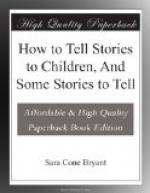Through the kindness of Miss Sweeney, I am able to insert several of these illustrations. They are entirely original, and were made without any thought of such a use as this.
The pictures and the retelling are both popular with children, but neither is as dear to them as the third form of reproduction of which I wish to speak. This third kind is taken entirely on the ground of play, and no visibly didactic element enters into it. It consists simply of playing the story.
When a good story with a simple sequence has been told, and while the children are still athrill with the delight of it, they are told they may play it.
[Illustration: THE FOX AND THE GRAPES]
[Illustration: “THERE WAS AN OLD WOMAN WHO LIVED IN A SHOE”]
“Who would like to be Red Riding Hood?” says the teacher; up go the little girls’ hands, and Mary or Hannah or Gertrude is chosen.
“Who will be the wolf?” Johnny or Marcus becomes the wolf. The kind woodchopper and the mother are also happily distributed, for in these little dramatic companies it is an all-star cast, and no one realises any indignity in a subordinate role.
“Now, where shall we have little Red Riding Hood’s house? ’Over in that corner,’ Katie? Very well, Riding Hood shall live over there. And where shall the grandmother’s cottage be?”
The children decide that it must be a long distance through the wood,—half-way round the schoolroom, in fact. The wolf selects the spot where he will meet Red Riding Hood, and the woodchopper chooses a position from which he can rush in at the critical moment, to save Red Riding Hood’s life.
Then, with gusto good to see, they play the game. The teacher makes no suggestions; each actor creates his part. Some children prove extremely expressive and facile, while others are limited by nature. But each is left to his spontaneous action.
[Illustration: “Great rats, small rats, lean rats, brawny rats ... followed the Piper for their lives.”]
In the course of several days several sets of children have been allowed to try; then if any of them are notably good in the several roles, they are given an especial privilege in that story, as was done with the retelling. When a child expresses a part badly, the teacher sometimes asks if anyone thinks of another way to do it; from different examples offered, the children then choose the one they prefer; this is adopted. At no point is the teacher apparently teaching. She lets the audience teach itself and its actors.
The children played a good many stories for me during my visit in Providence. Of them all, Red Riding Hood, The Fox and the Grapes, and The Lion and the Mouse were most vividly done.




